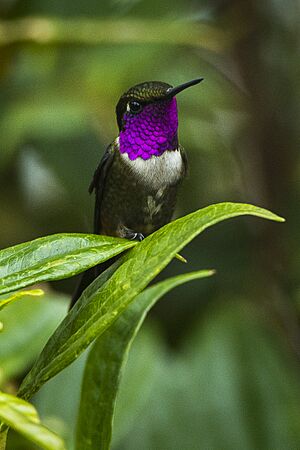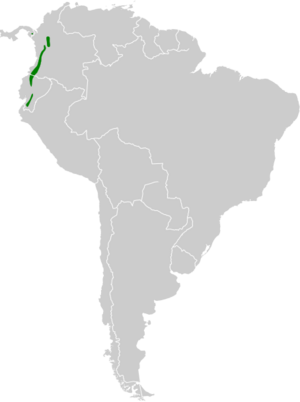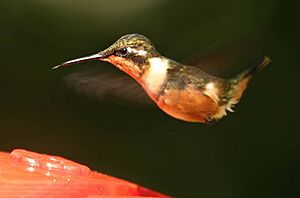Purple-throated woodstar facts for kids
Quick facts for kids Purple-throated woodstar |
|
|---|---|
 |
|
| Male | |
| Conservation status | |
| Scientific classification | |
| Genus: |
Philodice
|
| Species: |
mitchellii
|
 |
|
| Synonyms | |
|
Calliphlox mitchellii |
|
The purple-throated woodstar (Philodice mitchellii) is a tiny, colorful hummingbird. It lives in parts of Colombia, Ecuador, and Panama. This small bird is known for its bright throat feathers, especially in males.
Contents
About This Hummingbird
The purple-throated woodstar is a type of "bee hummingbird." This group includes some of the smallest birds in the world. Scientists place this bird in the Philodice group. It shares this group with the magenta-throated woodstar.
Some scientists used to put these birds in an older group called Calliphlox. But most now agree on Philodice. All experts agree that the purple-throated woodstar is a single, unique species. This means it does not have different subspecies.
What It Looks Like
The purple-throated woodstar is a very small bird. It is about 6.8 to 7.5 centimeters (about 3 inches) long. It weighs only 3.0 to 3.3 grams, which is less than a penny! Both male and female birds have a short, straight, black beak.
Their upper bodies are a dull bronze-green color. They also have a white patch on each side of their lower back. Males have a small white spot behind their eye. Females have a white line that curves downward behind their eye.
The male's throat is a shiny violet-purple. This bright patch is called a gorget. Below it is a white band. Their lower chest is a dull bronze, and their belly and sides are reddish-brown. The male's tail is forked and brownish-purple.
The female has a light, creamy white throat. It has dark speckles on the sides. Below her throat is a white band. Her lower chest is green, and her belly is reddish-brown. The middle feathers of her tail are bronze-green. The other tail feathers are cinnamon-colored with a black band near the end.
Where It Lives
The purple-throated woodstar lives in different areas. You can find it in eastern Panama's Darién Province. It also lives along the western Andes mountains in Colombia. From there, its range goes south into central Ecuador and southern Ecuador.
This hummingbird likes to live in humid forests. It can be found at the edges of these forests or deep inside them. It also lives in cloudforests. These are forests that are often covered in clouds. It lives from sea level up to 2,400 meters (about 7,900 feet) high. However, it is most common above 1,000 meters (about 3,300 feet).
How It Behaves
Seasonal Movements
In Colombia, these hummingbirds breed in higher mountain areas. After the breeding season, they often move to lower elevations. This is a type of short-distance migration.
What It Eats
The purple-throated woodstar mainly eats nectar from flowers. It looks for nectar high up in flowering trees. Some of these trees belong to the Cordia and Inga groups. Male birds will protect their favorite feeding spots from other birds.
Besides nectar, these birds also catch small insects. They do this by "hawking." This means they fly out from a perch, catch an insect in the air, and then return to their perch.
Reproduction and Life Cycle
The purple-throated woodstar breeds between December and May in southwestern Colombia. Scientists are still learning about its breeding season in other areas.
The female builds a tiny, cup-shaped nest. She uses fine plant fibers and spiderweb to make it. She usually places the nest on a thick branch of a tall tree. The nest is typically 8 to 12 meters (about 26 to 39 feet) above the ground.
The female lays two eggs. She sits on the eggs to keep them warm for 15 to 17 days. This is called incubation. How long it takes for the young birds to leave the nest is not yet known.
Sounds It Makes
Scientists have not fully described the purple-throated woodstar's song. However, its calls include a series of thin "chit" notes. It also makes a squeaky "kyee-kyee-kyee-kyee" sound.
Its Conservation Status
The IUCN (International Union for Conservation of Nature) has looked at the purple-throated woodstar. They have assessed it as a species of "Least Concern." This means it is not currently in danger of disappearing.
This bird lives in a specific area, but its population seems stable. Even though its exact population size is unknown, it is thought to be doing well. It is considered uncommon in some places but common in others. It seems to rely on native trees for its food. The good news is that it lives in at least two protected areas in Colombia.



